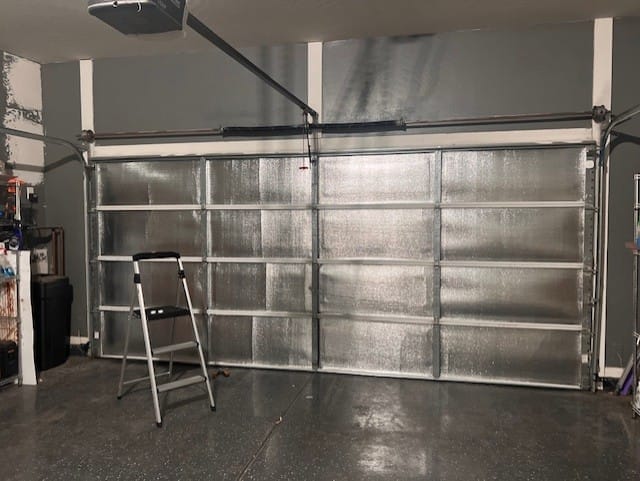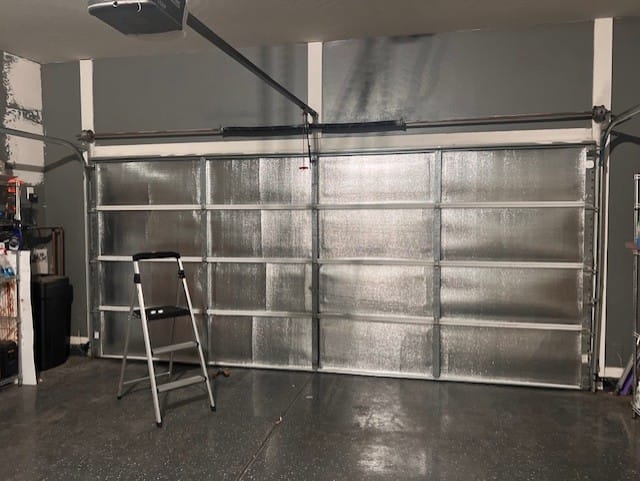The Quest For A Cooler Garage

I have a workshop that is in my garage. It's common for garages in the state of Arizona to not be insulated. In the summer, the temperature within the garage would exceed that of the outside by a few degrees. The heat is made worse if a hot car is placed within the garage. For a while I tried working in the garage, but it gets so hot that the computer I use to drive my CNC machine overheats and the condition unbearable. This post is about some of the few things I tried to remedy the extreme heat that can occur within a garage. Spoiler, I was able to lower the temperature by a few degrees, but not enough for it to be comfortable.
My first attempt at reducing the heat was through the use of a misting fan. I got one of these fans from the home depot:

This solution worked pretty well in terms of cooling, I would say the garage could easily be dropped by about 10 degrees with the aid of ice water. Unfortunatel no metrics was collected for this solution as there was one big flaw with it. The Mist would result in a big pool of water that gets everywhere. This is a bad option for electronics, so it's a nonstarter.
In my second attempt, I replaced the mist fan with a swamp cooler. Swamp coolers do not put out as much water as a mister, and all the water ends up back in the tank. Either the swamp cooler I got was not powerful enough for the square footage, or the swamp cooler as whole was ineffective. At most, the garage was only dropping by 2 degrees (F). I know it was working as the moisture level in the garage went from 20% to 40%. It's to be noted that with both misting and evaporative cooling, as the moisture level goes up, the cooling effective is reduced. In a closed room, the moisture level will rise until evaporative cooling is rendered useless.
As for my third attempt, I thought that maybe the extreme heat within the garage is the result of the poor airflow. In an effort to improve airflow I installed exhaust fans. Here is a link to the fans for reference:
https://www.amazon.com/dp/B0DRJ3MM48?ref_=ppx_hzsearch_conn_dt_b_fed_asin_title_3
The fan was installed on 6/6, as indicated by the red line. From the data below we can see that a an exhaust fan does not reduce the maximum temperature within the garage. Having the exhaust fan helps with how fast the temperature decreases at night, after the sun goes down. Prior to installing the fans, the inside temperature would be hot for longer. After the install, the plateau of each peak below is less wide, meaning it stays hot for less time.

For the Fourth and final attempt until the foreseeable future, I attempted to reduce the temperature by installing a radiant barrier. A lot of places will sell these kits that can be installed on the garage door.

The garage door is notoriously bad for radiating heat because it's made of metal, and metal has a high convection effect. So by installing this, the external heat radiation can be kept outside. Unfortunately internal heat is kept inside. With the barrier installed here is the result:

The green line indicates that date on which the barrier was installed. Analyzing the data, it's inconclusive whether the radiant barrier helps with the reducing the maximum temp within the garage. Perhaps where it could help is in bouts of extreme heat, where it is looking like the inside temperature can be up to 10 degrees cooler when the outside temperature is 115, but there is not enough data points to prove otherwise.
It should also be noted that with barrier installed, the lows do not get as low as previous. This could the consequence of parking cars within the garage at night, which is a heat source. The barrier at night works to the opposite effect where it is keeping heat inside.
In the summer this is undesirable, but when winter comes, the radiation barrier should ideally keep the temperature warmer for longer when cars are parked inside.
Conclusion
In the end all four attempts made a difference to the internal temperature of the garage, but not enough of a difference to make inhabiting the garage comfortable. Perhaps if my garage was strictly a workshop more work can be put into insulating the garage. It is, however, still a full service garage.. So fully insulating the garage will have the opposite effect of keeping the heat that the cars give off insulated inside the garage. A normal operating temperature for a car is 220F. To cool down the inside of the garage when a car is parked will require Air conditioning units, which will result in high electricity.